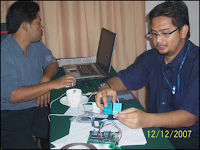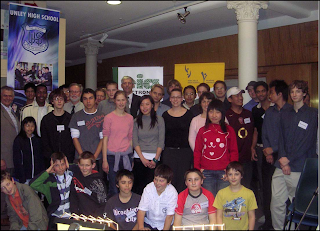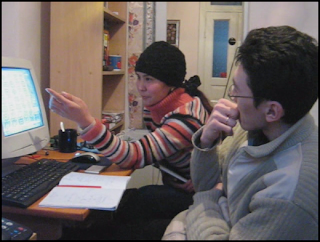Monday, March 24, 2008
Keep the comments coming!
Don't forget to donate and tell your friends about this project.
Please also bookmark this page and come back often for updates!
Thank you.
Sunday, March 23, 2008
The Malaysian Side of the Story
 We wanted to train these villagers so that they gain a valuable skill that is very much sought after. So that they can start making their own creative inventions. So that they can start a new breed of knowledge-driven society. So that they can become valuable human capital and realize our Vision 2020.
We wanted to train these villagers so that they gain a valuable skill that is very much sought after. So that they can start making their own creative inventions. So that they can start a new breed of knowledge-driven society. So that they can become valuable human capital and realize our Vision 2020.  I have also worked on this project over the recent summer holidays (Jan-Feb 2008), together with a team from Astana Digital Sdn. Bhd., the sole distributor of CoreChart in Malaysia. We met with various key people from both the government and private sectors. We focused on initiating a mentoring program where university students are trained in CoreChart, and then they will go to high schools to teach basic Robotics to the Malaysian students. The program will be very similar to the widely-acclaimed Robotics Peer Mentoring Program we have in South Australia.
I have also worked on this project over the recent summer holidays (Jan-Feb 2008), together with a team from Astana Digital Sdn. Bhd., the sole distributor of CoreChart in Malaysia. We met with various key people from both the government and private sectors. We focused on initiating a mentoring program where university students are trained in CoreChart, and then they will go to high schools to teach basic Robotics to the Malaysian students. The program will be very similar to the widely-acclaimed Robotics Peer Mentoring Program we have in South Australia. Unfortunately, although they agreed that this is good for Malaysia, they seemed to be more interested in something that we have never thought of. Something like "who's going to pay if the mentors got into an accident while on his way to the schools?". Or even "what if the uni mentors start flirting with the high school girls?". Seriously. These are some of the 'killer' questions they gave us. Questions that form the barrier to Malaysia's progress.
Unfortunately, although they agreed that this is good for Malaysia, they seemed to be more interested in something that we have never thought of. Something like "who's going to pay if the mentors got into an accident while on his way to the schools?". Or even "what if the uni mentors start flirting with the high school girls?". Seriously. These are some of the 'killer' questions they gave us. Questions that form the barrier to Malaysia's progress.Such questions are sure stoppers!
Obviously, telling them the benefits are just not enough to drive these people to take the project seriously. We needed something more. Something stronger and more powerful. Something that would make them set aside their own personal agenda.
Now imagine if the Kyrgyzstan people did get their chance (with your help) to present their story in WCIT08. The media will then do their job and start telling the whole world about this project. The Malaysian WCIT will then be one of the most successful events ever that changed the world.
But then, wouldn’t it be a shame if Malaysia herself is not doing anything to her people? We are the host country, but we are doing nothing to help our own people. We are talking about world poverty relief, but our own people are still suffering? It would be totally foolish if the government doesn’t do anything about it.
Once the word spreads out, it would definitely ring a bell inside the minds of those people in Malaysia whom we have met and introduced CoreChart to before (remember those 'killer' questions?). This bell would be so loud that the word 'CoreChart' will be in their head all the time. It will keep on ringing every time they see a microchip embedded product. That is, until they finally contact my friends at Astana Digital to get back on the project. To help our own people.
So there you go. That's the reason why I need your help.
From my experience, I am absolutely convinced that the Kyrgyzstan villagers' presentation at WCIT will promote Malaysia as the host that has a long term vision for poverty eradication.
Make this effort a fight for Malaysia's future, if you will.
Donate now and make your mark!
PS: Please also see The Australian Side of the Story. By signing the petition linked on that page, you are sending the similar message to Malaysians so that this project could be implemented in Malaysia too. Remember, Australia could be starting the race, but Malaysia could finish it first!
Go to Home
Go to The Enabling Technology
Go to The Next Step
Go to The Australian Side of the Story
Go to The Malaysian Side of the Story
The Australian Side of the Story

Now that sounds great, right? But imagine the first thing that those kids will do once they get their hands on the computers; chatting, play games, look up their favourite celebrities, or maybe some even worse things on the internet. That wouldn't be good, would it? What was supposed to be making a revolution in education turned out to be a new problem throughout Australia. Parents will then be angry, instead of having more respect, towards Mr Rudd.
So now, there is a suggestion to include CoreChart into each of the computers. This is the same software that the Kyrgyzstan villagers are using to develop their microchip products. Retired electronics engineers have developed a proposal for the Australian PM to match his visionary one million free computers project with one million CoreChart licences in order to develop a world class knowledge based industry to fill in the void left by the departing or departed businesses like Electrolux, Mitsubishi, Motorola etc.

Imagine if 1 million Australian kids get their free computers with CoreChart pre-installed. They would then have a 10-year head start into a very sought after skill. Just look at how much CoreChart has changed the lives of those Kyrgyzstan villagers. These kids will then be able to fast track the development of world class ICT knowledge workers.
Andy Leong, a student of The University of Adelaide, South Australia, has set up a petition so that we all can support the suggestion. This petition is one of the channels that we are using to get the attention of the Australian government. Click on the title below to go to the petition:
Match PM Rudd’s One Million Free Computers with One Million Free CoreChart Licences
In particular, note comment number 97 & 98 on the petition. These are from Colin Pridham, the Co-ordinator of the Kyrgyzstan project.
Now imagine if (with your help) the Kyrgyzstan people did get their chance to present their story in WCIT, and then the Australian government did agree to the proposal. That would definitely lift Australia’s image as a world champion in poverty eradication. It will be a very strong win-win situation, both for Australians and the poor people all over the world.
That is why we need to make sure both projects are a success. The synergy of this success will definitely change the world for the better.
So wait no more and sign the petition now!
And donate now to make the effect even bigger! (click the ChipIn! button on the top left side panel to donate)
Match PM Rudd’s One Million Free Computers with One Million Free CoreChart Licences
Go to Home
Go to The Enabling Technology
Go to The Next Step
Go to The Australian Side of the Story
Go to The Malaysian Side of the Story
Thursday, March 20, 2008
The Next Step

Approximately 2500 delegates and 100 reporters will congregate to seek solutions for Poverty Eradication using IT technologies. The delegates include iconic Social Entrepreneurs like Bill Gates, Prof Yunus, Prof CK Pralahad, CEOs, Heads of governments etc. WCIT is often billed as the 'Olympics of IT'.
If the villagers are able to showcase their story, this Malaysian WCIT will be remembered as the best of them all. It will be recorded in the history books as the starting point where poverty eradication is tackled with a proven sustainable and scalable model.
We need your help to raise funds to pay for flight, accommodation and WCIT2008 registration fee for three TalasTronics villagers to present their Poverty Relief projects in Malaysia. The total sum anticipated is A$10,000.
This is your chance to join our journey in this world-transforming effort.
If you feel that this effort is genuine and are willing to contribute, please donate.
Your $20 (or even $10) could actually change the life of half of the world population. We appreciate any amount that you could offer. I would also suggest that you get your friends and donate as a group, as then the processing fee is lower.
You can either donate to me in cash (if you are in Adelaide), or just click the ‘ChipIn!’ button on the top left side panel. It will bring you to a PayPal page, where you can choose to use PayPal, major credit cards or even some bank accounts.
We all hope that the Kyrgyzstan Villagers will prove once and for all there is hope and help for the 3 billion under privileged people!
Go to Home
Go to The Amazing Villagers
Go to The Enabling Technology
Go to The Next Step
Go to The Australian Side of the Story
Wednesday, March 19, 2008
The Enabling Technology
So as you can see, microchips have a HUGE impact on our lives. That's why the world demand for microchip programmers is soaring. However, the extremely steep learning curve makes it a very exclusive skill.
The key enabling technology here is CoreChart, a revolutionary software which makes programming microchips a child's play. Seriously. I have met with 9- and 10-year old kids who can program microchips. Impressive, isn't it?
In other words, CoreChart is to microchips as what Microsoft Windows is to computers. Without Windows, computers would still be an odd thing to many of us. Similarly, with CoreChart, now everyone can program microchips, even the poor people without formal higher education.

Instead of text-based as in the traditional way of programming microchips, CoreChart uses graphical flowcharts which are much easier to understand and implement.
However, unlike other graphical programming softwares, each flowchart icon in CoreChart translates directly into one assembly language instruction. This results in a powerful, high efficient programming, while being so easy to use.
CoreChart is developed by eLabtronics, a South Australian based company.
Go to Home
Go to The Amazing Villagers
Go to The Enabling Technology
Go to The Next Step
Go to The Australian Side of the Story
The Amazing Villagers
Breaking news:
Kyrgyzstan Villagers Program Microchips
 TALAS, Kyrgyzstan - A team of local villagers are becoming masters of an otherwise elite skill - microchip programming. With the help of STLI and Peace Corps volunteers, they have learned to program microchips to develop niche microchip embedded products to improve the quality of life.
TALAS, Kyrgyzstan - A team of local villagers are becoming masters of an otherwise elite skill - microchip programming. With the help of STLI and Peace Corps volunteers, they have learned to program microchips to develop niche microchip embedded products to improve the quality of life.
Currently, they are working on 5 projects using the PIC16F819 microcontroller from Microchip Technology Inc:
- Milk pasteurisation (monitoring milk boiling to help prevent Brucellosis),
- Candle making temperature control (making good quality candles),
- Pump temperature monitoring (keeping it above freezing in sub-zero temperatures),
- Anemometer wind speed measurement (power generation possibility),
- Soil control (monitoring green house conditions)
 Registered under the name TalasTronics (NGO), this amazing team are offering control solutions to local businesses to dramatically improve efficiency. While the businesses are gaining more profit, these villagers are in reality helping themselves to break their cycle of poverty.
Registered under the name TalasTronics (NGO), this amazing team are offering control solutions to local businesses to dramatically improve efficiency. While the businesses are gaining more profit, these villagers are in reality helping themselves to break their cycle of poverty.*****
Isn't it just amazing?
Villagers who are less educated than us can actually program microchips and make money out of it. These Kyrgyzstan people have proven to us that there is a way to harness the power of microchips to eradicate poverty. That’s what we are trying to do here. And you too, can be part of this.
Yes, but still, how can this eradicate poverty?
The volunteers from STLI and Peace Corp have trained these Kyrgyzstan villagers to program microchips with the hope of turning them into micro businesses and customers of businesses. They have formed TalasTronics (NGO) to develop low cost niche microchip embedded products to improve the quality of life of the villagers.
 This process will create competition for businesses to supply finance and materials to these niche micro businesses. We believe TalasTronics is a sustainable and scalable Poverty Eradication model. That means, the same model could be copied all over the world to achieve the aim of breaking the poverty cycle.
This process will create competition for businesses to supply finance and materials to these niche micro businesses. We believe TalasTronics is a sustainable and scalable Poverty Eradication model. That means, the same model could be copied all over the world to achieve the aim of breaking the poverty cycle.
In other words, we are not giving them a fish. We are also not teaching them to fish, because the number of fishes might be limited. Instead, we are teaching them to breed their own fish. So that they can eat whenever they want, and as much as they want.
If you want to know more about what these people have achieved, go here.
To understand more of TalasTronics' business model, click the image below to enlarge it:
Go to Home
Go to The Amazing Villagers
Go to The Enabling Technology
Go to The Next Step
Go to The Australian Side of the Story
Comments please!
Don't forget to spread the word.
Thanks.
My name is Arif.
I have a confession to make.
I am affected by a disease called Teenage Affluenza.
YOU might be affected too.
Watch this video and diagnose yourself.
3 billion people in the whole world lives under the poverty line. That is almost half of the world population. The only cure to Teenage Affluenza is to help these less fortunate people.
What we do
We are raising funds to get a team of villagers from Kyrgyzstan to attend the World Congress on Information Technology (WCIT) on 18-22 May 2008 in Kuala Lumpur, Malaysia. The aim of this effort is to present a sustainable and scalable poverty eradication model to the whole world.
Why we do it
 We believe that these villagers have the perfect solution to eradicate poverty by harnessing the power of technology. They not only help themselves break from the cycle of poverty, but at the same time making local businesses more profitable. Registered under the name TalasTronics (NGO), their method is truly unique – programming microchips.
We believe that these villagers have the perfect solution to eradicate poverty by harnessing the power of technology. They not only help themselves break from the cycle of poverty, but at the same time making local businesses more profitable. Registered under the name TalasTronics (NGO), their method is truly unique – programming microchips.
We need your help to raise funds to pay for flight, accommodation and WCIT2008 registration fee for three TalasTronics villagers to present their Poverty Relief projects in Malaysia. The total sum anticipated is $10,000.
If you feel that this effort is genuine and are willing to contribute, please donate.
Your $10 (or any amount you could give) could actually change the life of half of the world population. We appreciate any amount that you could offer.
You can either donate to me in cash (if you are in Adelaide), or just click the ‘ChipIn!’ button below or on the top left side panel. It will bring you to a PayPal page, where you can choose to use PayPal, major credit cards or even some bank accounts.
We all hope that the Kyrgyzstan Villagers will prove once and for all there is hope and help for the 3 billion under privileged people!
Want more information?
Click on the links below to read more about this project.
Go to The Amazing Villagers
Go to The Enabling Technology
Go to The Next Step
Go to The Australian Side of the Story
Go to The Malaysian Side of the Story

